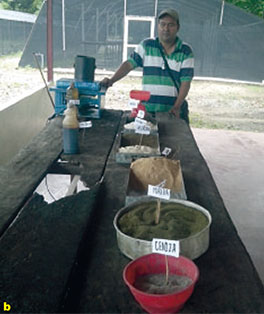Training program for the production of animal feed with local resources
Abstract
The plant biodiversity of the tropics has high availability of resources for animal production. Cereals, legumes, oilseeds, roots, tubers, natural grasslands, arboreal plants, and others that allow us to think about the sustainability of ruminant and non-ruminant animal production.
Currently there is an economic situation in the country, which affects the costs of commercial balanced foods, which are very high, due to the prices and availability of traditional raw materials in the national market. For the producer who supports his small units with commercial feed, it is very difficult for him to stay in animal production, this forces him to look for alternative food that is available and cheaper.
Producers have identified and quantified some resources for animal production, however, these resources are often limited in their use due to the absence of local technologies that make them available to be supplied to animals. Therefore, training plans, where producers and technicians are taught the methods of formulation, processing and food elaboration, using the available resources is of great importance. In this order of ideas, the technical team of animal nutrition of the National Institute of Agricultural Research of the state of Barinas (INIA Barinas), decided to implement a training program in formulation, processing and preparation of balanced feed with local resources.
References
Berrios, A. y M. Cardona. 2001. Evaluación productiva de una dieta alternativa como reemplazo parcial de concentrado comercial en aves de posturas. Rev. Col. Ciencias. Pec. Vol. 14:2.
Delgado, E. Y. Orozco y P. Uribe. 2013. Comportamiento productivo de pollos alimentados a base de harinas de plátano considerando la relación benefi cio- costo. Revista Zootécnica Tropical, 31(4): 279-290 pp.
Pérez, J. y M. Torrealba. 2011. Formulaciones de alimento balanceados para pollos, bovinos de carne, y porcinos considerando diferentes etapas de crecimiento, utilizando materias primas alternativas. Tesis de grado. Vicerrectorado de infraestructura y procesos industriales. Unellez. San Carlos. 20-50 pp.
Ortiz, M., P. Lara, M. Lara y J. García. 2010. Evaluación de la harina de hoja de morera (Morus alba) en la alimentación de pollos de engorde. Revista Zootecnia Tropical 28(4): 477-487 pp.
Trompiz, J., A. Gómez, H. Rincón, M. Ventura, N. Bohórquez y A. García, A. 2007. Efecto de raciones con harina de follaje de yuca sobre el comportamiento productivo de pollos de engorde. Revista Científi ca, FCV-LUZ, vol. XVII. N° 2, 143-149 pp.


